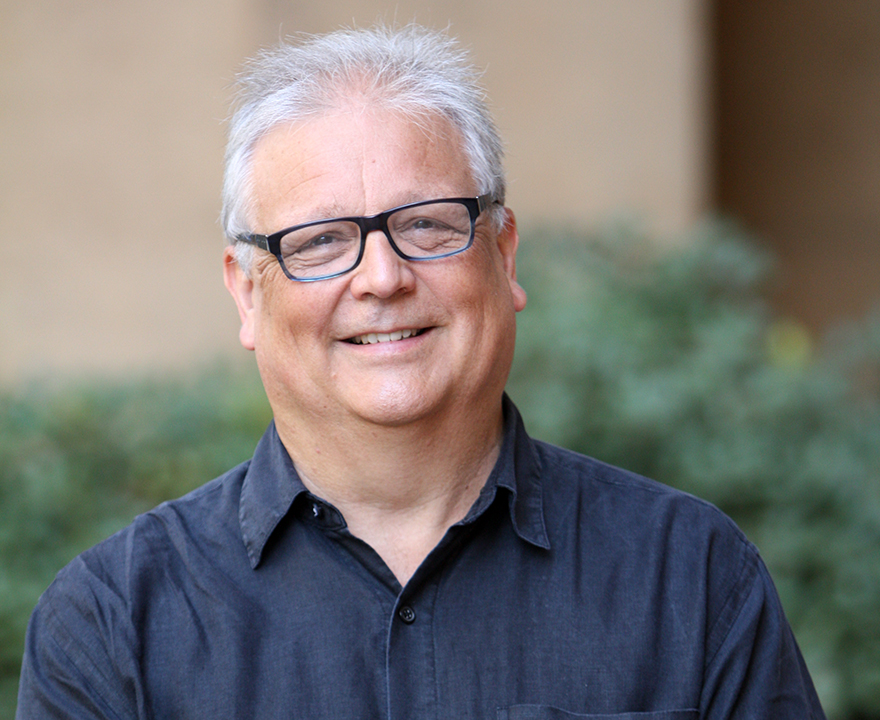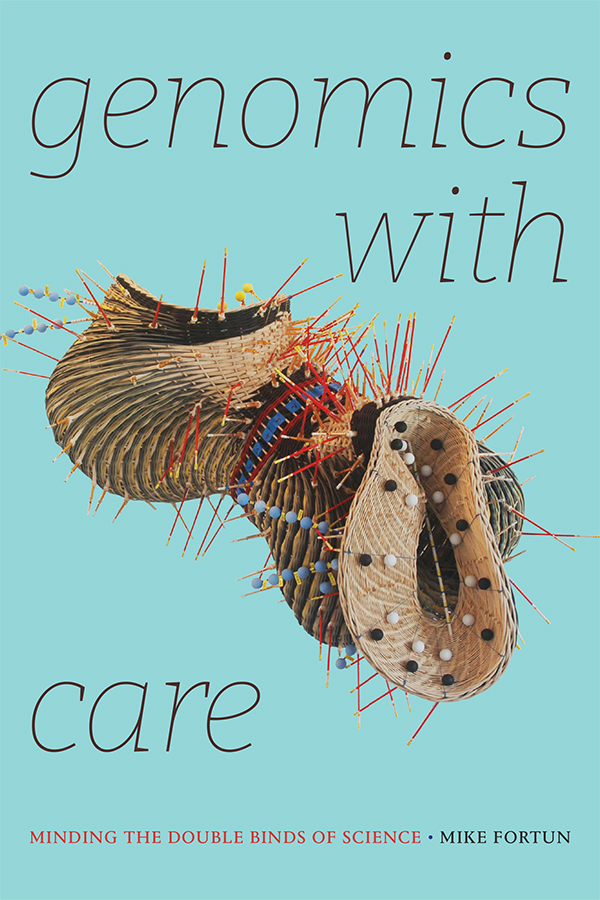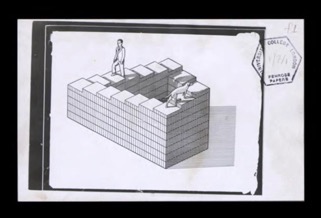
Genomics with Care: Minding the Double Binds of Science
 In his new book, Genomics with Care: Minding the Double Binds of Science (Duke University Press), UCI anthropologist Mike Fortun takes an anthropological approach to the study of care
in science. Spanning more than three decades of fieldwork spent alongside genomicists
from the genetics era of the 1980s to the subsequent rise of genomics in the 1990s
and the "post-genomics" developments in the 2000s, Fortun examines four distinct patterns
of care that have helped shape each new era. Below, he expands on why, when we reach
the limits of science, “when the methods stop working and the rules stop applying,”
something as seemingly simple as care is critical to the future of scientific discovery.
In his new book, Genomics with Care: Minding the Double Binds of Science (Duke University Press), UCI anthropologist Mike Fortun takes an anthropological approach to the study of care
in science. Spanning more than three decades of fieldwork spent alongside genomicists
from the genetics era of the 1980s to the subsequent rise of genomics in the 1990s
and the "post-genomics" developments in the 2000s, Fortun examines four distinct patterns
of care that have helped shape each new era. Below, he expands on why, when we reach
the limits of science, “when the methods stop working and the rules stop applying,”
something as seemingly simple as care is critical to the future of scientific discovery.
Why is it important to bring an anthropological approach and perspective to the study of genomics?
Anthropology, in my view, is the human science of human complexity. It’s interpretive in that it analyzes what people actually do when they are doing something like, in my case, “science,” and how they make sense of what they are doing and thinking. Both of those doings – with your hands or body, and with words – are far more complex, more improvisational and creative, and ultimately far more interesting than our everyday, conventional understanding of them. The dominant cultural image of science, for example, is a simple and straightforward story of disinterested fact gathering, cool hypothesizing and cold calculatings, with precise experiments and exact logics resulting in a special kind of truth that we call objective: unbiased by human leanings, “pure” of any personal, political, or cultural taint, universal and demanding of total assent from anyone and everyone. But after at least a hundred years of historians of science, philosophers, sociologists, anthropologists, and scientists themselves analyzing science, we know that that simple narrative image of science doesn’t reflect what scientists do and how they do it.
My study of “genomics” and “care” goes along similar lines: we’re misled if we think these seemingly simple words point to one identifiable thing with sharp contours. Certainly, a word like “care” has a dominant cultural sense: it tends to be feminized, for example, which may explain why care work – nursing and housekeeping, for example – is both undervalued and most often done by women. Metaphorically speaking, care is soft and warm, while science is cold and hard. They are opposites that pertain to different domains. But when you read the scientific publications of genomicists carefully—and reading carefully for me means reading deconstructively and ethnographically—when you listen to genomicists talk about their work to each other or to an inquisitive anthropologist, another interpretation of both science (genomics) and care emerges in which they start to overlap and bleed into each other. There’s even a sense in which genomics and care become the same thing.
Give us a rundown on the concept of "genomic care" and how it encompasses both affective and cognitive forces.
Reading deconstructively means finding those places in both our common and specialized discourses where opposites that are supposed to be mutually exclusive, like science and care, show their incoherences and interdependencies. The same goes for affect and cognition, feeling and thinking. At some level, I think, we understand that thinking and feeling are uncannily alike in their difference. Or to put that differently (and illustratively): at some level, I feel, we sense that cognition and affect are uncannily alike in their difference. At least some neuroscientists and psychologists now recognize that the cognitive capacities of humans are productively tangled up with our affective capacities, and the relationship is more one of interdependence than exclusivity.
In my fieldwork among genomicists since the 1990s—listening to them, reading them and their writings, sitting with them as they go about their work—I became increasingly attuned to their regular expression, in speech and text, of surprise, excitement, anxiety, joy, and (subtly but most importantly to me) interest. These are the moments in experience and language that almost always get edited out in the scientific journal article. But they manage to peek through occasionally, and they positively abound in their memoirs, autobiographies, and their writing not in but about their science on blogs, on social media, and in the opinion or commentary sections that have proliferated in scientific journals.
Chief among such expressions were admonitions like “be careful,” or injunctions like “care is necessary when…,” or evaluative compliments like “she’s very careful.” I became interested in how ubiquitous such care-expressions were, and the high value that attached to them, but also how vague or indeterminate they were. So part of my ethnographic challenge became: how do I make sense of matters of “care” in genomics? How is “care” simultaneously crucial and unspecifiable?
The transition from genetics to genomics and then to "post-genomics" from the 1980s to today brought about significant conceptual, technological, social, and methodological changes. How did the patterns of genomic care evolve during these transitions, and what were the key challenges faced by scientists in navigating these changes?
Data is central to this story – constantly growing, diversifying, becoming interconnected. Before about 1990, scientists are doing genetics: identifying and analyzing one gene at a time, almost always connected in a relatively straightforward to a relatively easy to diagnose condition, like sickle cell anemia. Sequencing the DNA in or around genes was hard but also often kind of irrelevant to interesting genetic questions, which was why many scientists were not especially enthusiastic about the Human Genome Project in the 1990s: sequencing DNA was boring work, and many thought DNA sequence information itself wasn’t particularly interesting. But as sequencing became automated and less expensive, genetics became genomics: analyzing all of the genes in a person or another organism, and then increasingly wide comparative analyses of how the genomes of large groups of people differed from each other, more multispecies comparisons of sameness and difference, and on and on. Now scientists were not bored but excited by DNA sequence information. But the affect of excitement always weakens. And it became clear that all this genetic information required more protein information, it required more knowledge of biochemistry, it required clinical information, it required extended linkages to a widening scientific literature. Genomics was becoming “post-genomics,” and scientists began trying to analyze more complex conditions like asthma—the one that I follow in the book. And with conditions like that you need even more, and more diverse, data about how “the environment” – air, nutrition, social stressors, building conditions, pets, uteruses – may be interacting with the diversity of genes in the diversity of genomes in diverse peoples in diverse conditions. That’s a lot of difference and complexity, and requires ever-increasing levels of “care.”
In your book, you discuss four patterns of genomic care: curation, scrupulousness, solicitude, and friendship. Could you give some examples that illustrate these patterns and their impact on the development of genomics?
I tried to use the word “care” as little as possible when I was writing the book, which turned out to be next to impossible. Every use of it reinforced the sense that “care” had some identity, some essence, and I was trying to show how “care” has always been conceptually unruly. For me, it’s only a “good enough” name we give to how humans (including scientists) respond to an unruly reality. So I organized the four core chapters of the book under four near-synonyms for care: curation, scrupulousness, solicitude, and (the farthest linguistic stretch) friendship. Each names something that happens at the limit where one nested system of science verges on the next, more encompassing one: curation is the care necessary to move from data to its analysis; scrupulousness is the care that attends to each of the myriad elements (and their interconnections) of an experimental apparatus, so that new scientific truths can be produced; solicitude cares for an entire scientific domain like genomics, trying to comprehend an entire structure of knowledge production, and how its successes and accompanying failures are enmeshed in the world of culture and political economy; and friendship is the care that holds scientists, even if shakily, together as a community opening on to its yet-to-be-known-and-done future. The boundaries between these are a kind of internal limit to science, where the methods stop working and the rules stop applying, and something else has to step in; we can call that “care.”
Curation: genomics was one of the earliest and best candidate sciences for the promises of “Big Data.” Avalanches of DNA sequence information excited genomicists, even and maybe especially when they didn’t know what to do with it. But although data is considered foundational, inviolable, unyielding and untouchable, that frequently used word “avalanche” indicates one of what I call the double binds of science: data has to be free, wild, outside of human control and intent, and data has to be managed, repaired, watched over, cleaned, and otherwise constantly touched by caring human hands and minds. A double bind is two equally important demands that conflict; both can’t be satisfied, and both must be satisfied. I analyze the admirable but underappreciated care work that goes into creating and maintaining genomic data and data infrastructures, work that always has to be done but can never be done. The demand for curational care is endless.
Scrupulousness: as genomics data sets grew and avalanched, and experiments became more elaborate and more expensive as genomicists attempted to analyze increasingly complex conditions like asthma, where multiple genes have many small influences – or maybe none at all – genomicists found it easier to establish new associations between genes and complex conditions like asthma, to publish articles, and to accrue institutional and cultural credit. It also became easier to be misled, to chase false hopes, to waste time and money. And there was no evidently infallible way for a genomicist to tell which path they were on. In ancient Rome, a scruple was a tiny pebble placed in your shoe to cause a minimum amount of discomfort, a reminder that you had to pay attention or care about the small unseen things that can always disrupt the best laid plans, and your best intentions. I describe how genomicists continually invented a compendium of new “scruples,” mostly concerning matters of statistics, to more carefully navigate this territory where a thousand things have to be exactly right. And yet, if an experiment is truly an experiment, something has to be left out, unaccounted for, unknown.
Solicitude: the only way to account carefully for every aspect of a complex system is to have a sense of the whole. But if you knew what the genomic “whole” was—a complete understanding of asthma, say, or the full realization of genomic science—you wouldn’t be having to fund and run experiments in the first place. Another double bind. I discuss how genomicists would repeatedly come together to discuss and analyze how “genomics” as a system was not working, even as it was being extraordinarily productive—how scientific success and failure were both bound to each other. By soliciting—carefully shaking to find the places of movement or rigidity—the vast bio-techno-socio-cultural system of genomics, they don’t solve or dissolve the double binds of genomics, but they do create ways to fail better.
How do you see the relationship between care and scientific progress in the field of genomics? Are there instances where care becomes a hindrance to scientific advancements, or does it primarily drive creativity and change?
Care, then, is how all-too-human genomicists come to fail better at what they do. “Failing better” has very occasionally been recognized in the long history of the sciences as the philosophical method, narrative, or final goal that is the most appropriate way to how sciences are actually done and conceptualized. In the book I use the geneticist Lionel Penrose’s figure of the “impossible staircase” as an image of what genomics or any other science looks like from this perspective informed by anthropology and deconstruction, where contradictions come to the fore. In failing better, genomics is always moving forward, step by careful step—and it always finds itself in the same place.
 It’s a funny sort of progress, at odds with triumphal cultural narratives in which
heroic scientific geniuses use their purely rational minds to lead us upwards to final
truth. But to this anthropologist, anyway, it’s more realistic: we’re one step more
elevated, more enlightened, than we were before, but we’re no closer to an imagined
end which doesn’t actually exist. And it suggests a different affective register to
the doing of science, for scientists, and for scientific culture. Which brings up
my fourth pattern of care that I haven’t talked about yet:
It’s a funny sort of progress, at odds with triumphal cultural narratives in which
heroic scientific geniuses use their purely rational minds to lead us upwards to final
truth. But to this anthropologist, anyway, it’s more realistic: we’re one step more
elevated, more enlightened, than we were before, but we’re no closer to an imagined
end which doesn’t actually exist. And it suggests a different affective register to
the doing of science, for scientists, and for scientific culture. Which brings up
my fourth pattern of care that I haven’t talked about yet:
Friendship: what we can call Western science has for centuries been metaphorized as a kind of heteronormative romance between mind (culturally coded as male) and nature (coded as female). (This explains in part why so many scientific disciplines still have so far to go in terms of welcoming and advancing women.) Even at its best, this cultural imaginary of romantic love does a disservice to science and to scientists, where I think we can also read a different kind of ethos, that of friendship. We speak casually of “the scientific community,” but even a scientific community depends on some kinds of affective bonds that exceed logic and reason. This is a long and involved analysis toward the end of the book, and I’m not sure I always step wisely or surely, but I draw on feminist primatologists like Sarah Blaff Hrdy and Joan Silk who are among the leading re-interpreters of the story of human evolution. In a nutshell: as part of the longer evolution of primates, humans evolved to embody what anthropologist John Terrell calls “a talent for friendship.” We prefer cooperation over competition, not only because we are better off survival-wise when we share many weak bonds in a larger group, and not only because we are always dependent on the care of those many others. We prefer it because we are pro-social creatures, and it feels good to be among friends, lots of them, to care for them and to be cared for by them.
Those are the ethical implications of “genomics with care” that I hope readers, especially scientists, will find material in the book to think through: affects matter as much to science as logic and reason do, and you can’t be a good scientist if you aren’t care-ful. Take James Watson, of double-helix fame and a powerful figure in the Human Genome Project in the 1990s and beyond: his scientific achievements can’t be separated from his hyper-competitive, unscrupulous, individualist, elitist, and arrogant persona; no anthropologist, historian, or philosopher of genomics was at all surprised when the full dimensions of his misogyny and racism became widely known late in his life. The geneticist Bruno Lemaitre writes about how what he calls “the narcissistic type” of scientist, of which Watson is an extreme example, can become so successful in genomics and other sciences. But he also writes about the kinds of scientists that my book focuses on: the scientists driven by more modest pleasures, who find interest and some measure of excitement in cleaning up data or painstakingly adding detailed annotations to them. Who take joy in puzzling through why today’s experimental result doesn’t square with yesterday’s. Who do genomics thoughtfully and carefully, which turn out to be the same thing.


